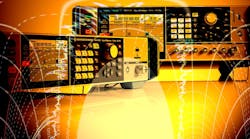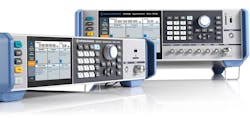Download this article as a .PDF
Evaluating the performance of modern receivers and many high-frequency components requires a test source capable of producing signals with quality exceeding that of the signals employed in the actual applications, whether the receivers or components are for commercial, industrial, or military use. The R&S SMA100B RF/microwave signal generator from Rohde & Schwarz provides test signals with impressive purity from 9 kHz through 20 GHz. In addition to high output power across the frequency range, it has low phase noise and low harmonic distortion. It provides the signal purity to meet the measurement needs of device, component, circuit, and system testing for everything from commercial wireless communications to military radar.
The R&S SMA100B RF and microwave signal generator is built in two different physical configurations (see figure): with 2 HU or 3 HU rack-mount housings and 5- and 7-in.-diagonal touchscreen displays, respectively. The display screens on both versions provide high, 800 × 480 pixel resolution. The signal generator is available in four models covering all or part of the full frequency range:
R&S SMAB-B103: 8 kHz to 3 GHz;
R&S SMAB-B106: 8 kHz to 6 GHz;
R&S SMAB-B112: 8 kHz to 12.75 GHz;
R&S SMAB-B120: 8 kHz to 20 GHz.
All four versions have outstanding spectral purity in common, with typical single-sideband (SSB) phase noise of -152 dBc/Hz offset 20 kHz from a 1-GHz carrier and -132 dBc/Hz offset 20 kHz from a 10-GHz carrier. The noise floor (wideband noise) is also very low, at a level of only -162 dBc measured 30 MHz from a 10-GHz carrier. Harmonics do not exceed -63 dBc across the full frequency range, even at the highest output-power levels, reaching as low as -70 dBc from about 15 to 20 GHz. Nonharmonic noise is -90 dBc at 10 GHz and as low as -100 dBc at the low end of the frequency range.
Judging by the low measured RMS jitter, signals generated with these sources are quite stable and qualified candidates for characterizing the performance of analog-to-digital converters (ADCs) and digital-to-analog converters (DACs). The RMS jitter is almost negligible: a mere 18 fs measured at both 622 MHz and 2.488 GHz. In fact, with an option (B29), the signal generators can provide the flexibility of selectable output waveforms: single-ended sinewaves, differential sine waves, differential square waves, and differential CMOS signals, with standard dc offsets to 3 GHz (or to 6 GHz with another option). The variety of waveforms supports testing of a wide range of analog, digital, and mixed signal devices.
The R&S SMA100B signal generators can perform frequency sweeps as wide as the full bandwidth of each instrument, in linear or logarithmic steps, with dwell times of 3 ms to 100 s between steps. The frequency tuning resolution is 0.01 Hz. The signal generators deliver high test signal output power, with as much as +38 dBm output power through 6 GHz, +30 dBm or more output power at 18 GHz, and +28 dBm output power at 20 GHz. With their precision electronic step attenuators, these signal generators can set output levels as low as -145 dBm in standard models, with resolution of 0.01 dB. The generators require less than 1 ms to settle to a new power level, for efficiency in automatic-test-equipment (ATE) applications.
In addition to the four frequency ranges, the signal generators are available in two different rack-mount versions: with 2 HU or 3 HU housings and 5- and 7-in.-diagonal touch-screen displays, respectively, with 800 × 480 pixel resolution for both screens. For those in need of modulation, there is plenty, with one option providing AM, FM, and phase modulation, and another option adding pulse modulation. The quality of the pulse modulation is noteworthy, since modulation is available with pulse widths of 20 ns or less and rise/fall times of 10 ns or better (and typically 5 ns). The on/off ratios of these pulses is better than 80 dB, and amplitude levels can be tightly controlled in pulses as narrow as 100 ns. The signal generators boast advanced digital automatic-level-control (ALC) circuitry to produce those leveled pulses, and the circuity can even level the tops of pulses from an external modulator.
The R&S SMA100B RF and microwave signal generators are obviously state-of-the-art test instruments with untouchable phase-noise performance and considerable output power across an almost 20-GHz bandwidth. The amount of testing that has gone into these signal generators prior to their release is impressive, with such parameters as level setting repeatability fully characterized across the full operating temperature range. The generators can emulate a wide range of legacy instruments from other vendors for ease of integration into ATE systems, and they are equipped with many user-friendly controls and features to simplify operation, such as context-sensitive help. If there is anything bad to say about these instruments, it is in the amount of options available, which extends not only to the size of the instrument but to the choice of reference clock (including a 1-GHz reference for extremely low phase noise when locking multiple signal generators) and maximum output-power level. The generators come with a three-year warranty.
Rohde & Schwarz GmbH & Co. KG, P.O. Box 80 14 69, 81614 Muenchen, Muehldorfstrasse 15, 81671 Munich, Germany


